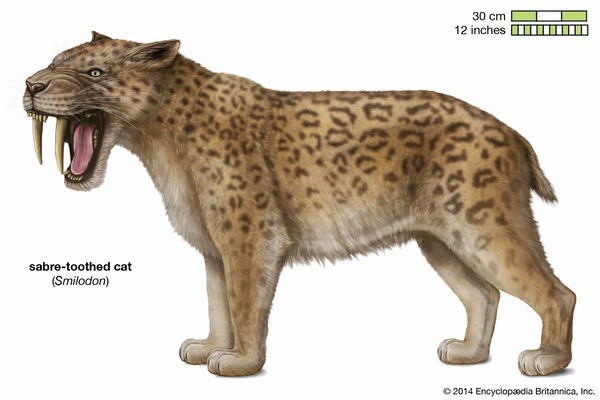rayscale: ; --tw-hue-rotate: ; --tw-invert: ; --tw-saturate: ; --tw-sepia: ; --tw-drop-shadow: ; --tw-backdrop-blur: ; --tw-backdrop-brightness: ; --tw-backdrop-contrast: ; --tw-backdrop-grayscale: ; --tw-backdrop-hue-rotate: ; --tw-backdrop-invert: ; --tw-backdrop-opacity: ; --tw-backdrop-saturate: ; --tw-backdrop-sepia: ; margin-top: 0px; margin-bottom: 1.25em; overflow-wrap: break-word; white-space: pre-wrap; color: rgb(20, 23, 24); font-family: __Karla_555e8b, __Karla_Fallback_555e8b, ui-sans-serif, system-ui, -apple-system, BlinkMacSystemFont, "segoe ui", Roboto, "helvetica neue", Arial, "noto sans", sans-serif, "apple color emoji", "segoe ui emoji", "segoe ui symbol", "noto color emoji"; letter-spacing: -0.16px; background-color: rgb(243, 245, 247);">The saber-toothed tiger (Smilodon) is an extinct large mammal belonging to a genus in the family Felidae. They lived in the late Pleistocene and became extinct about 12,000 years ago. Here is a detailed introduction to saber-toothed tigers:
rayscale: ; --tw-hue-rotate: ; --tw-invert: ; --tw-saturate: ; --tw-sepia: ; --tw-drop-shadow: ; --tw-backdrop-blur: ; --tw-backdrop-brightness: ; --tw-backdrop-contrast: ; --tw-backdrop-grayscale: ; --tw-backdrop-hue-rotate: ; --tw-backdrop-invert: ; --tw-backdrop-opacity: ; --tw-backdrop-saturate: ; --tw-backdrop-sepia: ; margin-top: 0px; margin-bottom: 1.25em; overflow-wrap: break-word; white-space: pre-wrap; color: rgb(20, 23, 24); font-family: __Karla_555e8b, __Karla_Fallback_555e8b, ui-sans-serif, system-ui, -apple-system, BlinkMacSystemFont, "segoe ui", Roboto, "helvetica neue", Arial, "noto sans", sans-serif, "apple color emoji", "segoe ui emoji", "segoe ui symbol", "noto color emoji"; letter-spacing: -0.16px; background-color: rgb(243, 245, 247);">
feature:
teeth:
The most obvious feature of the saber-toothed tiger is its huge canine teeth on the upper jaw, which can reach 30 centimeters in length. These canines are shaped like sword blades and are used to pierce the neck of prey when hunting.
Body type:
Saber-toothed cats were generally larger than modern large cats, reaching a length of up to 3 meters, a shoulder height of about 1.2 meters, and a weight of about 250 to 400 kilograms.
living environment:
Sabre-toothed tigers mainly inhabit the American continent, especially the grasslands, deserts and forests of North and South America. They live in advantageous hunting locations and mainly prey on large mammals such as beasts of prey and large ungulates.
Behavioral characteristics:
The saber-toothed tiger was a carnivorous animal whose large canine teeth in its upper jaw revealed its hunting skills. They were probably team hunters, able to work together to hunt large prey.
Extinction:
The saber-toothed tiger was a late Pleistocene species that became extinct about 12,000 years ago. The cause of its extinction is not yet clear, but it may be due to a variety of factors such as climate change, reduced prey numbers, and human activities.
Research and Fossils:
Through the study of fossils, scientists have learned about the living habits, feeding habits and behavioral characteristics of saber-toothed tigers. Fossils of saber-toothed tigers have been found throughout North America, South America and Europe.
Although the saber-tooth cat became extinct thousands of years ago, its powerful hunting characteristics and large upper jaw canine teeth have made it one of the focuses of paleontology. Studying saber-toothed cats helps us better understand past biodiversity and ecosystems on Earth.
animal tags: tiger
We created this article in conjunction with AI technology, then made sure it was fact-checked and edited by a Animals Top editor.